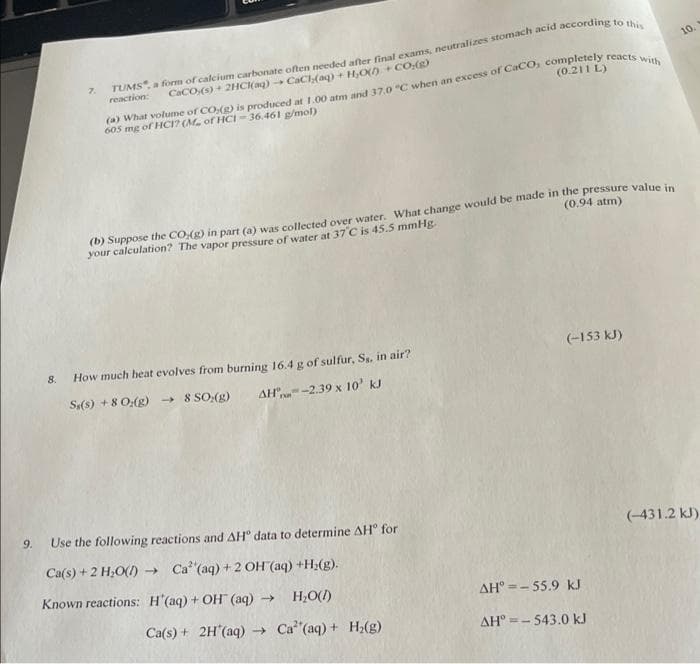(-153 kJ) 8. How much heat evolves from burning 16.4 g of sulfur, S, in air? S(s) + 8 0,(g) → 8 SO:(g) AH"-2.39 x 10' kJ 9. Use the following reactions and AH° data to determine AH° for (-431.2 kJ) Ca(s) +2 H,O() Ca"(aq)+2 OH (aq) +H2(g). Known reactions: H'(aq) + OH (aq) → H,O() AH° =- 55.9 kJ Ca(s) + 2H'(aq) → Ca (aq) + H;(g) AH° =- 543.0 kJ
(-153 kJ) 8. How much heat evolves from burning 16.4 g of sulfur, S, in air? S(s) + 8 0,(g) → 8 SO:(g) AH"-2.39 x 10' kJ 9. Use the following reactions and AH° data to determine AH° for (-431.2 kJ) Ca(s) +2 H,O() Ca"(aq)+2 OH (aq) +H2(g). Known reactions: H'(aq) + OH (aq) → H,O() AH° =- 55.9 kJ Ca(s) + 2H'(aq) → Ca (aq) + H;(g) AH° =- 543.0 kJ
Introduction to Chemical Engineering Thermodynamics
8th Edition
ISBN:9781259696527
Author:J.M. Smith Termodinamica en ingenieria quimica, Hendrick C Van Ness, Michael Abbott, Mark Swihart
Publisher:J.M. Smith Termodinamica en ingenieria quimica, Hendrick C Van Ness, Michael Abbott, Mark Swihart
Chapter1: Introduction
Section: Chapter Questions
Problem 1.1P
Related questions
Question

Transcribed Image Text:10.
7.
CaCO,(s) + 2HC(ag) CaCH(aq) + H,O) + CO:()
(a) What volume of CO,(g) is produced at 1.00 atm and 37.0 "C when an excess of Caco, completely reacts wi
605 mg of HCI? (M of HCI - 36.461 g/mol)
reaction:
(0.211 L)
(b) Suppose the CO,(g) in part (a) was collected over water, What change would be made in the pressure value in
your calculation? The vapor pressure of water at 37 C is 45.5 mmHg.
(0.94 atm)
8.
How much heat evolves from burning 16.4 g of sulfur, Ss, in air?
(-153 kJ)
Sy(s) + 8 0:(g) → 8 SO:(g)
AH"n-2.39 x 10' kJ
9.
Use the following reactions and AH° data to determine AH° for
(-431.2 kJ)
Ca(s) + 2 H;O() → Ca (aq) +2 OH (aq) +H2(g).
Known reactions: H'(aq) + OH (aq)
->
H,O()
AH° =- 55.9 kJ
Ca(s) + 2H (aq) → Ca (aq) + H;(g)
AH° =- 543.0 kJ
Expert Solution
This question has been solved!
Explore an expertly crafted, step-by-step solution for a thorough understanding of key concepts.
Step by step
Solved in 2 steps with 1 images

Recommended textbooks for you

Introduction to Chemical Engineering Thermodynami…
Chemical Engineering
ISBN:
9781259696527
Author:
J.M. Smith Termodinamica en ingenieria quimica, Hendrick C Van Ness, Michael Abbott, Mark Swihart
Publisher:
McGraw-Hill Education

Elementary Principles of Chemical Processes, Bind…
Chemical Engineering
ISBN:
9781118431221
Author:
Richard M. Felder, Ronald W. Rousseau, Lisa G. Bullard
Publisher:
WILEY

Elements of Chemical Reaction Engineering (5th Ed…
Chemical Engineering
ISBN:
9780133887518
Author:
H. Scott Fogler
Publisher:
Prentice Hall

Introduction to Chemical Engineering Thermodynami…
Chemical Engineering
ISBN:
9781259696527
Author:
J.M. Smith Termodinamica en ingenieria quimica, Hendrick C Van Ness, Michael Abbott, Mark Swihart
Publisher:
McGraw-Hill Education

Elementary Principles of Chemical Processes, Bind…
Chemical Engineering
ISBN:
9781118431221
Author:
Richard M. Felder, Ronald W. Rousseau, Lisa G. Bullard
Publisher:
WILEY

Elements of Chemical Reaction Engineering (5th Ed…
Chemical Engineering
ISBN:
9780133887518
Author:
H. Scott Fogler
Publisher:
Prentice Hall


Industrial Plastics: Theory and Applications
Chemical Engineering
ISBN:
9781285061238
Author:
Lokensgard, Erik
Publisher:
Delmar Cengage Learning

Unit Operations of Chemical Engineering
Chemical Engineering
ISBN:
9780072848236
Author:
Warren McCabe, Julian C. Smith, Peter Harriott
Publisher:
McGraw-Hill Companies, The